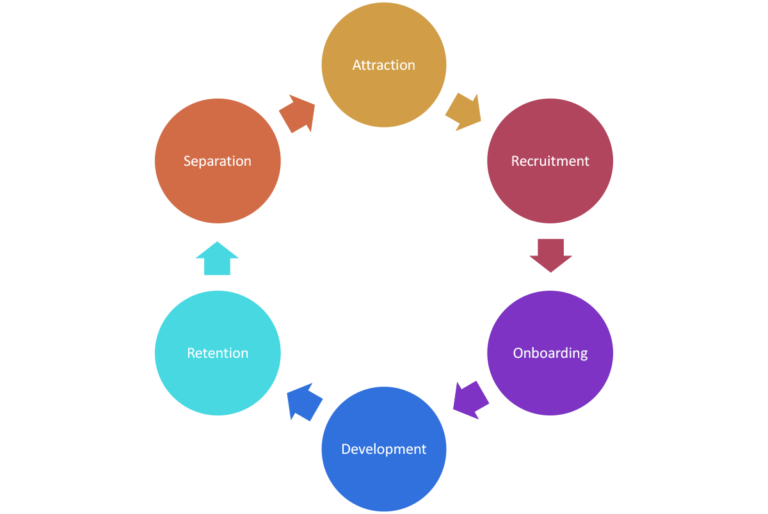Building Engagement Throughout the Employee Lifecycle
Whether it’s before their first day at work, or after their resignation letter has been delivered, or anywhere in between, positive engagement has significant value during every phase of your employee’s journey.
By now you’ll know how passionate we are about experience-driven onboarding – it’s the foundation of everything we do here at Enboarder.
However, onboarding represents just one portion of the employee lifecycle. It’s equally important to ensure employee engagement occurs throughout all phases of the employee lifecycle.
What is the employee lifecycle?
The employee lifecycle refers to a natural progression of phases in the way an employee interacts with your organization.
The employee lifecycle consists of six stages:
- Attraction
- Recruitment
- Onboarding
- Development
- Retention
- Separation

Of course, it’s not the only model out there, but the employee lifecycle model is useful because:
- The six stages are easy to distinguish from each other, and fairly universal to all employees;
- These distinguishable stages all have their own associated strategies for building engagement; and
- The fact that the model is a cycle, rather than a linear A-to-B journey, helps us realise that engagement at each stage has a reinforcing or looping effect on the rest of the stages.
Especially surprising is that engaging with an outgoing employee at the Separation stage actually has a flow-on effect for the next Attraction and Recruitment stages.
The obvious question then is how? And why bother?
What is to be gained from constant engagement with employees (including even those on their way out of the company)?
Why employee engagement matters (no matter where in the cycle)
As the lifecycle model indicates, there is no point at which you can sit back on your laurels and stop engaging with your employees (or potential employees).
In fact, there are considerable competitive advantages that your business can realize by having a strategic, comprehensive approach to employee engagement at each phase of the cycle.
For example, consistent engagement throughout the employee lifecycle delivers benefits for recruitment, retention and productivity.
How?
How employee engagement makes Recruitment easier
Did you know that almost 70% of new hires come from employee referrals? We also know that referrals tend to yield candidates of higher quality. So much so that many organizations have a referral program in place to encourage their staff to help fill vacancies by referring suitable friends and family.

Not surprisingly, disengaged employees simply aren’t motivated to make good referrals. Just consider it – who would refer a friend or colleague for a job at a company they feel indifferent or negative about?
So by all means, continue to incentivise referrals, but pair those programs with a consistent approach to employee engagement. This will massively increase the probability of generating high quality recruitment referrals.
Moreover, maintaining consistent engagement vastly expands your opportunities to take advantage of boomerang hires – that is, those employees who have left your company in search of greener pastures and later seek to come back home. (More on this a bit later.)
Retention benefits from employee engagement
It’s a fact that engaging onboarding practices are essential for keeping new hires. But what about retaining employees across the entire lifecycle?

As found in Aberdeen’s April 2016 report An Employee-centric Digital Workplace: From Onboarding Through Engagement and Retention:
” . . . businesses with a formal [engagement] strategy in place are 8% more likely (emphasis added) than All Others (81% vs. 75%) to retain their first-year employees. Not only does an engagement strategy have an impact on performance, but it also pays off for retention. In today’s digital workplace, small returns like that can’t be overlooked.”
Employee engagement boosts Productivity
Employee engagement is also key to more productivity, happier customers, and sustained revenue growth.
This is borne out in Aberdeen’s April 2016 report which found:
“Companies with a formal engagement strategy in place are 67% more likely (emphasis added) to improve their revenue per FTE on a year-over-year basis.”
The logic here is also fairly straightforward – engaged employees want to work harder for your company. This naturally leads to the benefits described above, ultimately ending in improvements to your bottom line.
How to build employee engagement at each stage of the lifecycle
Now we know why employee engagement matters. Let’s see how we can boost engagement at each phase:
1. Building engagement during the Attraction phase
The attraction phase occurs well before an employee is actually recruited, perhaps even before they become a true candidate. At this stage, the potential employee is researching companies and their values, and reading online workplace reviews such as those at Glassdoor & LinkedIn.
The interpersonal dimension is also important – they are almost certainly asking their personal and professional circles about the reputation of an organization, and if they have had any experience dealing with the company, whether as employees, partners, or consumers.

From Beamery’s blog:
“Successful candidate engagement starts long before someone is ready to click apply, some of the most important work that a modern recruiting department can do is to educate the market on their employer brand and their [employer value proposition].”
To build engagement with potential employees in the Attraction phase, use your employer and consumer branding to address the real desires and interests of your prospective candidates, recognising who they are as people, and what they really desire as part of their employee experience. It’s important to keep your approach consistent across multiple channels, including events, your website and social media, and wherever else your message is broadcast.
It’s also useful to have a careers section on your website, where you can provide a one-stop shop for potential employees. Showcase employee experience and stories, provide an updated listing of career opportunities, and include mechanisms like forms or chat to make it easy for potential employees to reach out to you.
Maximising engagement at this stage ensures you also maximise your talent pool, helping ensure you receive the best possible list of candidates to choose from.
2. Recruitment with engagement
Keeping candidates engaged is a very human process, as explained by Beamery’s blog:
“Candidates expect the same treatment as consumers. They want relevant engagement from companies based on where they are in the candidate journey, and what kind of role that they’re actually interested in. They want the same level of personalization that they receive from sophisticated marketing departments.
“It’s about creating a candidate experience that feels real, human and authentic (emphasis added). It’s about building relationships with people, not just processing resumes.”

Maintaining candidate engagement, and creating positive candidate experience, is therefore about more than just conversations between recruiters and candidates.
As TLNT suggests, the rules of engaging candidates include:
- personalised communication
- focusing on getting to know your candidates before addressing roles directly
- identifying gaps in each candidate’s current employment
- building a value proposition unique to the candidate
- knowing when to back off
Again, the message here is recognising and responding to the human element inherent in every candidate experience. Candidates want and need regular touchpoints in order to stay engaged, and need to be kept updated on the entire recruitment process so that they aren’t just “left hanging” at any stage. Doing so shows you care about your candidates, and leaves a positive impression that translates to better recruitment outcomes.
Don’t be afraid to utilise more innovative digital methods such as video recruiting, allowing you to showcase the flexibility and forward-thinking aspects of your organisation!
3. Engagement-focused Onboarding
This is what we at Enboarder are all about!
To be fair, it’s hard to cover the depth and breadth of what we have to say on engagement onboarding in a small space like this.
Suffice to say that your organisation really needs a comprehensive system in place that effectively connects your managers to your new hires in order to maximise engagement and thereby improve employee experience. In a nutshell, this is how you stop yourself losing those valuable new hires to early attrition.
Successful engagement onboarding is more than ticking off new hire checklists, filling out induction paperwork or kowtowing to the compliance gods. It’s about creating engaging and memorable employee experiences when welcoming new employees to your organisation.

The key here is to build a connection between new hires and the organisation by using engagement tools such as:
- personalisation
- real-time communication
- automated reminders
- visually intuitive induction timelines
It’s about keeping those new hires feeling comfortable, excited and valued, fully maintaining their emotional momentum for their new role while delivering on all your brand promises.
It’s also essential to remember that the onboarding period is more than just the first few days or weeks of a new hire’s role – rather it includes preboarding, i.e. the time before your new employee’s critical first day, as well as a period of time that extends months past the employee’s starting date. (Yes, months!)
Extending your “onboarding mindset” is the key here. With just a little open-mindedness, it’s easy to see that covering all your onboarding bases isn’t actually all that hard. It mostly just requires you to recognise those times when your employees need support and genuine engagement to keep them happily rolling along.
4. Engage and Develop
Employees don’t just work in your organisation, they also learn and grow. In fact, “opportunities for personal development” is among the key reasons why employees will stay with a company. People feel happy and engaged when they are learning something new and useful, as they are benefitting personally and occupationally in ways far beyond what a mere salary can provide.

Despite this, time for learning at work is typically scarce. New research by Josh Bersin shows that 46% of professionals spend less than 1 hour per week on learning. However, he concludes that the happiest and most productive workers are the “heavy learners” that spend more than 5 hours per week on learning and professional development.
Of course, how we learn at work, and the future of learning, is still in a developmental phase itself. Nevertheless, here are a few things you can do to keep the learning happening:
- Foster connections between employees to allow mutual and often spontaneous learning (helping and teaching one other).
- Establish mentorship programs, utilising the expertise of your staff to systematically teach your less experienced members.
- Offer independent learning and upskilling opportunities that allow each employee to work at their own best pace.
- Create career progression paths, with clear opportunities for employees to transition to new, meaningful roles.
- Obtain continuous feedback from employees about their aspirations and what the organisation can do to help push them to the next step of the ladder.
- Consider utilising gamification, or learning through play, as a way to increase interest in learning, and as a natural means of absorbing new information.
- Recognise that many people “learn by doing”, also known as experiential learning, and provide opportunities for employees to step outside their career comfort zones.
- Build a culture of learning, and make it an integral part of your organisation’s everyday activities.
This is just a start, but we reckon it’s a pretty good one.
5. Engage to Retain
Retaining employees in the long run is largely about helping employees build a true connection with their peers and the company as a whole. Material employment benefits are of some value here, but genuine employee recognition is an even more indispensable hallmark of successful retention programs.
Recognition can be given via many different means in the workplace, but the message is always the same: Thank you. We value your work. You matter to us.

Are you providing sufficient recognition?
Do your employees feel valued and appreciated?
To answer these questions, you must continuously reach out to your employees to gauge their sentiment. Remember, communicate with them, find out how they are feeling toward you. Don’t be an ostrich.
And don’t forget, there are many reasons why employees may stay with a company. According to Aberdeen’s June 2017 report Strengthening Employee Engagement Across the Employee Lifecycle, these are the top ones:
- Relevance of work to the company
- Work is challenging
- Rewards and recognition
- Work-life balance
- Wellness resources
- Career growth and development
- Transparency of company goals
- Role consistency
- Ability to chart a career path
In delivering an effective retention program, it is essential that organisations not only design their systems around fulfilling these employee values, but that they also successfully communicate to their employees their intentions of fulfilling them. This helps ensure that employees know and appreciate what you are doing for them, rather than potentially just taking it for granted.
6. Separation phase
It might not be obvious at first, but an employee’s decision to voluntarily separate from your organisation is a perfect reason to keep that engagement coming.
Possibly the most important reason for this is that happy employees, even happy former employees, are a superb source of new hire referrals (as we mentioned earlier). Alumni employees continue to build on their substantial networks of colleagues, ex-colleagues, friends and family, and as a result continue to provide employment referrals and recommendations.
Providing positive engagement during the separation phase means your former employees are far more likely to continue feeling good toward you, the former employer who worked tirelessly to take employee experience to the next level (that’s you, right?).

Maintaining continuous low-touch engagement with them thereafter will keep your brand at the top of their minds, helping to ensure you are first cab off the rank when referral time comes around. This then feeds back into benefits in both the attraction and recruitment phases, meaning that none of the hard work you put into employee engagement is ever really lost – even if your employees have already resigned!
Furthermore, great engagement during separation helps you capture more boomerang hires. As mentioned earlier, boomerang hires are those individuals who once were your employees, and find their way back again to work for you. Although this situation can come with pros and cons depending upon the individual employee, there are often many benefits to making such hires. Remember, the engagement experienced by the employee in the separation phase of their lifecycle has a lasting effect on their attitude toward the company. If you want to get boomerang hires, stay engaged and connected right up to, and even beyond, each employee’s point of departure from your organisation.
A few things to keep in mind for maintaining engagement in this phase include:
- Utilise effective offboarding processes including exit interviews and appropriate feedback mechanisms to learn everything you can from the employee’s departure and to show them you care about their loss to the organisation.
- Create and maintain alumni channels allowing you to keep in touch and interact with valuable employees who have left.
- Where appropriate, promote directly to your valued leavers, sharing current role opportunities and anything else that might highlight positive growth and development on the part of your company.
The key here is simply to realise that, although departed from you, your former employees are still a potential source of referrals and pool of talent. This pool also comes with the particular benefit of already being familiar with your company, thereby minimising the time and resources needed to integrate them again into your organisational family.
Connecting the dots on employee engagement
So, you’re engaging your employees at every stage of their lifecycle, and maybe things are going pretty well. Now what?
If you’ve successfully conquered the challenge of ongoing employee engagement, it is still imperative that your engagement levels remain consistent and maximised throughout each phase of the cycle. No single phase of engagement can be thought of as truly more important than the other, as each is a critical link in a chain of employee experience that has an enormous impact on key HR metrics. And of course, a chain is only as strong as its weakest link.
And then, if you’ve done it right, you might get to enjoy the glowy warm feeling of your employees turning into your most passionate advocates. Arriving at this advanced stage has a lot to do with employee interconnectivity, often achieved through providing an organisational platform where employees can, for example, collaborate powerfully, share job openings, and express their admiration of your company through social media channels. This is where letting employees be themselves is at its most powerful, as your employees will naturally be your biggest fans, and their advocacy will come from the only place that matters – the heart.
Do you want your employees fully engaged and transforming into dedicated advocates of your organisation? Find out more about how we do this at Enboarder.